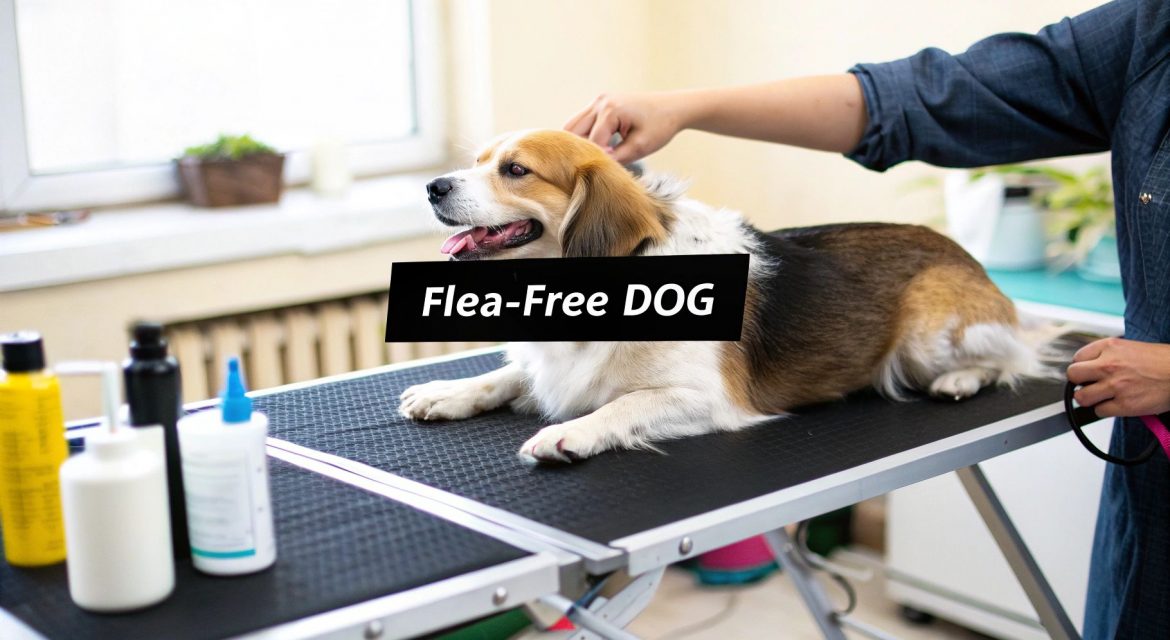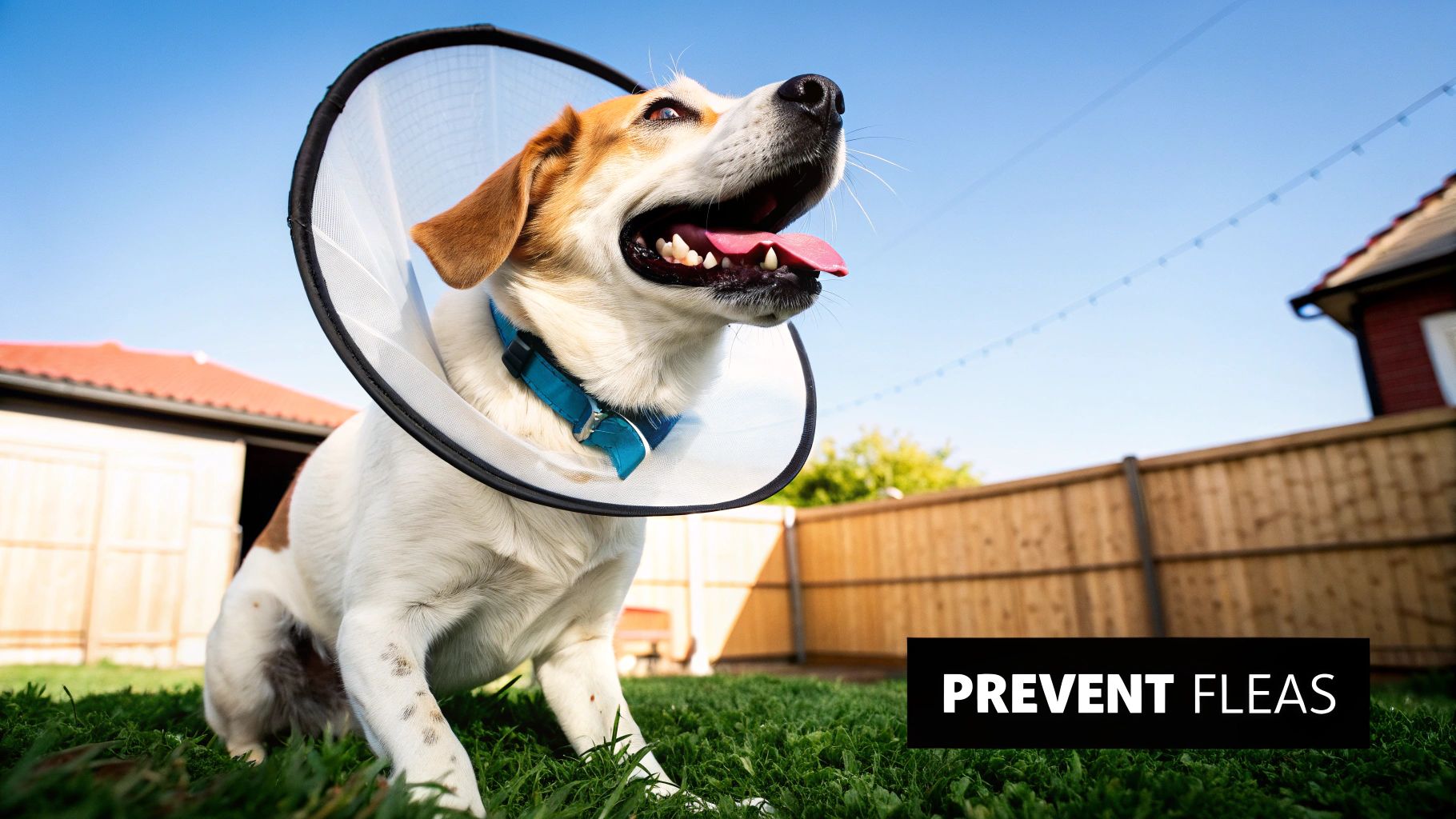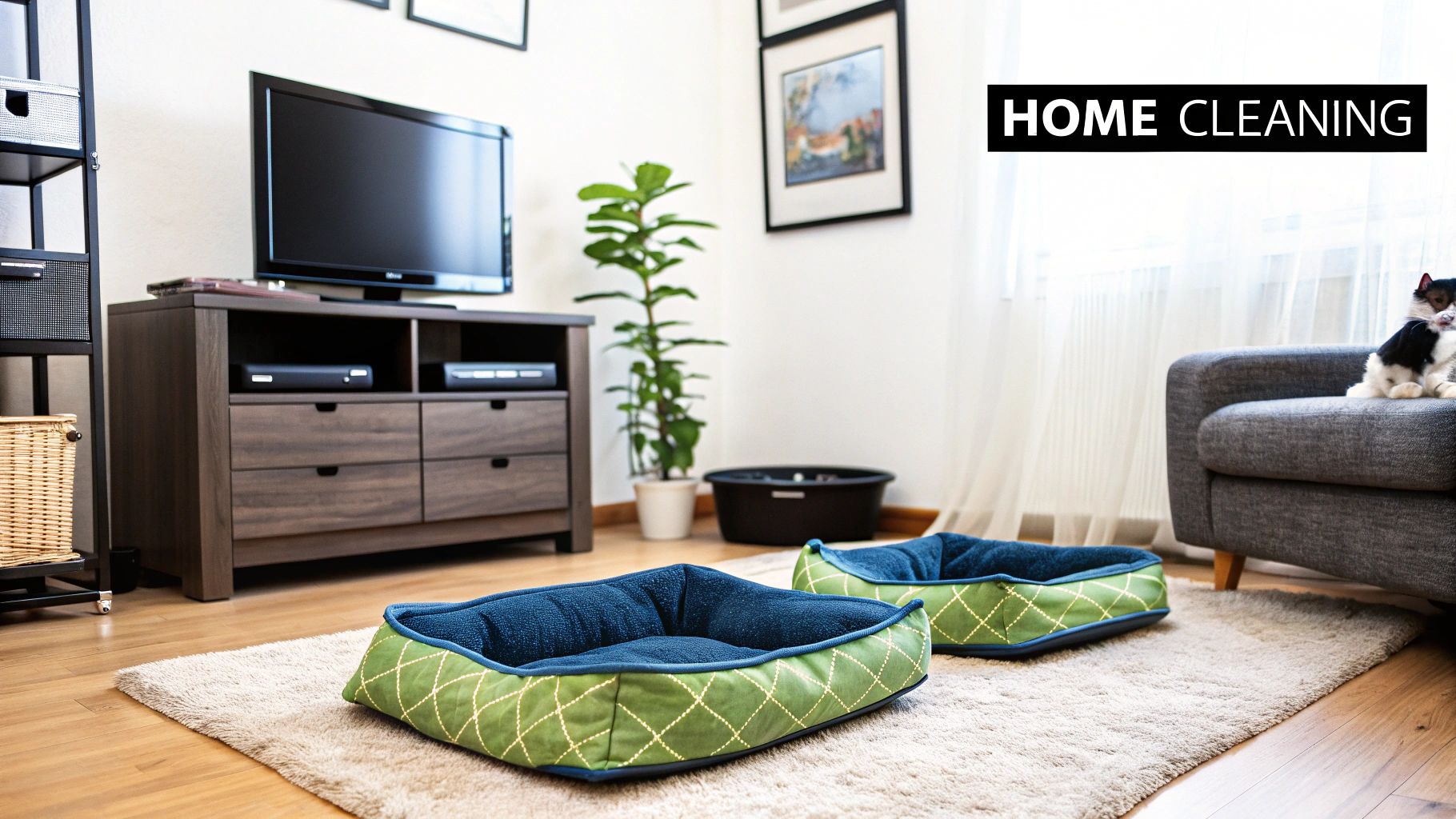Let's face it, dealing with fleas is one of those moments every dog owner dreads. Tackling dog fleas control effectively comes down to two key things: first, being absolutely sure you're dealing with fleas, and second, having a calm, organised plan of attack. We understand it can be overwhelming, but it’s all about knowing the signs and acting decisively to protect your best mate and your home from these nasty little pests.
Confirming a Flea Problem and Your First Moves
We’ve all seen it. That sudden, frantic scratching or chewing that makes your heart sink. It’s so easy to panic and jump to the worst conclusion, but we're here to walk you through this, step by step.
Before you declare all-out war on your home, your first job is to confirm that fleas are actually the culprits. Other troublemakers, like skin allergies or mites, can look very similar. A few minutes of detective work now will save you a world of time, money, and stress later on.
Spotting the Telltale Signs
The most obvious clue is the relentless scratching, of course. But fleas leave other evidence behind. You might notice your dog is restless, their skin is red and sore, or they're losing fur—especially around the base of their tail, their lower back, and hind legs. These are classic flea hotspots.
If you’re lucky (or unlucky, depending on how you look at it), you might even spot a live flea. They’re tiny, dark brown, and incredibly fast. They can jump huge distances, which is why they’re so difficult to catch a glimpse of.
A single female flea can lay up to 50 eggs per day. This isn't just a small problem; it’s one that can escalate into a full-blown infestation before you know it if left unchecked.
The most reliable evidence you'll find is something we call "flea dirt". It’s a polite term for flea faeces, which is essentially your dog's digested blood. In your dog’s coat, it looks just like tiny black specks of ground pepper.
Flea Identification Checklist
To make this easier, here’s a quick checklist you can use to inspect your dog for the common signs of a flea problem. We’ve been there, and having a guide helps.
| Symptom to Check | What It Looks Like | How to Confirm |
|---|---|---|
| Intense Scratching/Biting | Frantic, persistent scratching or chewing, often at the back, tail base, or groin. | Observe your dog's behaviour. Is it more than their usual itch? |
| Red, Irritated Skin | Small red bumps or sore-looking patches of skin under the fur. | Part the fur in common flea areas (back, tail, tummy) and look closely. |
| Hair Loss | Thinning fur or bald patches, especially around the lower back and hind legs. | Compare fur density in different areas. The base of the tail is a key spot. |
| Live Fleas | Tiny, dark brown, fast-moving insects that jump when disturbed. | Use a flea comb and good lighting. They are most active in warm spots. |
| "Flea Dirt" | Looks like specks of black pepper scattered in the fur. | The most reliable sign. Use the paper towel test described below to confirm. |
This table should help you quickly pinpoint the issue. Finding any of these signs, especially flea dirt, is a strong indicator that you need to take action.
The Paper Towel Test: Your Definitive Answer
The best way to know for sure if those black specks are flea dirt is with a simple test you can do at home.
- Grab your tools: You just need a fine-toothed flea comb and a sheet of white kitchen roll or paper towel.
- Comb your dog: Gently run the comb through your dog’s fur, making sure the teeth get right down to the skin. Focus on their lower back, the base of the tail, and their belly.
- Check the comb: After a few strokes, tap the comb's contents onto the white paper towel.
- Add a drop of water: If the black specks dissolve into reddish-brown or rust-coloured streaks, you've found flea dirt. That's the digested blood, and it's definitive proof fleas have been feeding on your poor pup.
Finding confirmation can feel a bit gut-wrenching, but please know you haven't done anything wrong. Flea infestations are incredibly common. Recent UK studies found that even with modern preventative treatments, 14.4% of dogs had fleas during the peak summer months. Interestingly, over 90% of fleas found on dogs are actually cat fleas, which just shows how easily they spread between pets. You can read more on these findings about flea prevalence in the UK.
Seeing that red smear on the paper towel can be disheartening, but what you’ve just done is incredibly important. You’ve moved from anxious wondering to knowing exactly what you're up against. Now, you have a clear enemy and can start putting a solid plan together. Take a deep breath. We'll get through this together.
Choosing the Right Flea Treatment for Your Dog
Stepping into the pet care aisle or browsing online for dog fleas control can feel like a minefield. The sheer number of boxes—spot-ons, tablets, collars, shampoos—all promising to be the perfect fix can leave you completely frozen with indecision. We get it. You just want to make the right choice for your dog, but how do you know which product is actually the best fit?
Let's cut through that confusion together. Choosing the right flea treatment isn't about finding one single "best" product, but about finding the best one for your dog's unique situation and lifestyle.
Understanding Your Main Treatment Options
The core of modern flea control really boils down to a few key types of products. Each works in a different way and is suited to different needs. Think of it like a toolkit; you just need to pick the right tool for the job.
First up, you have spot-on treatments. These are the little liquid pipettes you apply directly to the skin on the back of your dog's neck. The active ingredients get absorbed into the skin or spread through the natural oils on their coat, killing fleas on contact or when they bite. They are incredibly popular because they're simple to apply and usually give protection for a full month.
Next are oral tablets and chews. You give these to your dog just like a treat, and they work from the inside out. When a flea bites your dog, it ingests the medication from their bloodstream and dies very, very quickly. A lot of dog owners like us love these because there's no greasy mess and you don't have to worry about your dog getting wet right after. Some tablets can start killing fleas in as little as 30 minutes, making them a fantastic weapon against a severe, active infestation where your poor pup needs immediate relief.
Then you've got flea collars. We know what you might be thinking, but today's medicated collars are a world away from the old, smelly ones. Modern collars slowly and continuously release active ingredients that spread over your dog's body, offering long-lasting protection for up to eight months. They are a brilliant "set it and forget it" option for long-term prevention.
Finally, there are flea shampoos. These are mainly for the immediate, on-the-spot killing of fleas already on your dog. While a good flea bath can provide instant relief and wash away all that horrible flea dirt, it has no lasting preventative effect. As soon as your dog is dry, they're vulnerable again to new fleas jumping on for a ride. Shampoos are best used as part of a bigger strategy, not as your only line of defence.
Matching the Treatment to Your Dog
So, how do you decide? The best choice really hangs on a few key factors.
-
For a Severe, Active Infestation: If your dog is absolutely miserable and crawling with fleas, you need speed. An oral tablet is often the best first strike. It gets to work almost instantly, killing the adult fleas and giving your dog that much-needed relief. You can then follow up with a longer-lasting preventative.
-
For Convenient Monthly Prevention: If you're good with a monthly routine, spot-ons and oral chews are both excellent choices. The decision often comes down to personal preference. Do you have small children who are always petting the dog? An oral chew might be better to avoid any topical residue. Does your dog have a sensitive stomach? A spot-on could be a gentler option.
-
For Long-Term, Low-Maintenance Prevention: If you're the kind of person who struggles to remember monthly doses (no judgement here, we've all been there!), a medicated collar is a fantastic solution. It provides consistent protection for months on end, making it perfect for busy households.
It's also really important to think about your dog's health and lifestyle. A dog who loves to swim might not be the best candidate for certain spot-on treatments, which could make an oral tablet a more reliable choice. Similarly, your dog's overall health plays a big role. A well-balanced diet supports healthy skin, which is their first line of defence. For more on how food impacts their wellbeing, you can explore our detailed guide on dog nutrition.
Crucial Vet Advice: Always, always consult your veterinarian before starting any new flea treatment. This is non-negotiable for puppies, senior dogs, pregnant dogs, or any dog with a pre-existing health condition. Your vet knows your dog's complete health history and can recommend a product that is both safe and effective for their specific needs.
Weighing the Pros and Cons
Let's pull it all together. Here’s a quick comparison to help you see the options side-by-side.
| Treatment Type | Key Advantage | Best For | Main Consideration |
|---|---|---|---|
| Oral Tablets/Chews | Very fast-acting; kills fleas quickly. | Severe infestations and easy monthly prevention. | Some dogs may have sensitive stomachs. |
| Spot-On Treatments | Easy to apply; reliable monthly protection. | Consistent, routine prevention. | Can leave a residue; water exposure may affect some brands. |
| Medicated Collars | Very long-lasting protection (up to 8 months). | Low-maintenance, long-term prevention. | Must be fitted correctly to work; initial cost can be higher. |
| Flea Shampoos | Kills fleas on contact instantly. | Immediate relief during a bath. | No residual effect; does not prevent re-infestation. |
At the end of the day, you are your dog's greatest advocate. By understanding how these products work and thinking about your dog's unique life, you can move forward with confidence. You're not just picking a box off a shelf; you're making a smart, informed decision to protect their health and happiness.
Winning the Battle Against Fleas in Your Home
Here’s a thought that can feel a bit overwhelming, but it’s the absolute key to success: treating only your dog is a battle you are guaranteed to lose. It’s a tough pill to swallow, but up to 95% of a flea infestation—the eggs, larvae, and pupae—lives in your home environment, not on your furry friend. We are going to tackle this head-on, together.
This means effective flea control is a two-front war. You’ve chosen a treatment for your pup, which is a fantastic start. Now, we need to reclaim your home. It might sound like a massive undertaking, but breaking it down room by room makes it completely manageable. Let's turn that feeling of dread into a clear, actionable plan.
Your Immediate Cleaning Offensive
The moment you confirm fleas, it’s time to get the washing machine and vacuum cleaner working. This isn't just a quick tidy-up; it's a strategic mission to remove as many flea life stages as possible.
First, gather up everything that can be washed. This includes:
- Your dog’s bedding (a major flea nursery)
- Any blankets or throws they love to snuggle on
- Soft toys and plushies
- Your own bedding, cushion covers, and throws, especially if your dog joins you on the sofa or bed
You need to wash these items on the hottest cycle the fabric can handle. A hot wash, ideally 60°C or higher, is crucial because it will kill not just adult fleas, but also the more resilient eggs and larvae. A cool wash simply won't cut it.
Mastering the Art of Vacuuming
Next, it’s time for the vacuum cleaner, your most powerful ally in this fight. The vibrations from a vacuum can actually encourage dormant pupae to hatch, exposing the new adult fleas to any treatments you've used on your pet or in your home. This is a good thing!
Be methodical. Vacuum everything, and we mean everything.
- Carpets and Rugs: Go over them slowly, in multiple directions, to really agitate the fibres.
- Upholstered Furniture: Use the attachments to get into every crevice and seam of your sofas and armchairs. Don't forget to vacuum under the cushions.
- Floors and Skirting Boards: Pay special attention to the edges of rooms and any cracks in wooden flooring where flea larvae love to hide.
- Pet Hotspots: Give extra attention to the areas where your dog spends the most time sleeping or resting.
After you finish vacuuming, this next step is non-negotiable. Immediately take the vacuum outside, remove the bag, seal it tightly in another plastic bag, and dispose of it in your outside bin. If you have a bagless model, empty the canister into a sealable bag outside and wash the canister thoroughly with hot, soapy water.
This prevents any captured fleas or eggs from simply crawling back out and re-infesting your home. Don't skip this part!
Demystifying Household Flea Sprays
For a persistent infestation, vacuuming alone might not be enough. This is where a good-quality household flea spray comes in. It can feel a bit daunting to spray chemicals in your home, but modern products are very effective when used correctly.
Look for a spray that contains an Insect Growth Regulator (IGR). This is the most important component. While the main insecticide in the spray kills the adult fleas you can see, the IGR works differently. It acts like a flea birth control, preventing the eggs and larvae from developing into biting adults. This is how you break the life cycle for good.
Here's a simple process for using a household spray safely:
- Test First: Always spray a small, hidden patch of carpet or fabric first to make sure it doesn't cause any discolouration.
- Ventilate: Open all the windows to get good air circulation.
- Remove Pets: Keep all pets (not just your dog, but cats, birds, and small animals too) and people out of the room you are treating. Cover fish tanks completely and turn off their pumps.
- Spray Systematically: Lightly spray the carpets, skirting boards, underneath furniture, and your dog’s bedding. There's no need to saturate everything; a fine mist is all you need.
- Let It Dry: Leave the room and let the spray dry completely, which usually takes a few hours. Keep it well-ventilated during this time.
Once it's dry, it's safe for everyone to return. Remember, fleas are not only irritating; they can also transmit diseases. For instance, ticks, another common parasite, are known carriers of serious illnesses. We have a helpful guide if you'd like to learn more about the risks of Lyme disease in dogs.
This infographic illustrates the core cycle of successful dog flea control.
The visual makes it clear that treating your dog, cleaning your home, and repeating the process are three interconnected steps essential for long-term success.
Building a Sustainable Flea Prevention Plan
Okay, you’ve done the hard work. You’ve treated your dog, blitzed the house, and can finally breathe a sigh of relief. But the real win in the fight against fleas isn't just getting rid of them once; it's making sure you never have to go through that ordeal again.
This is where we shift gears from frantic, reactive cleaning to calm, consistent prevention. A smart, year-round plan is your golden ticket to a flea-free life. It’s all about building simple habits that become second nature, protecting your dog and your own peace of mind.
The Cornerstone of Prevention: Consistency
The single most important part of any long-term flea plan is consistency. It only takes one missed dose of a monthly treatment for a new infestation to take root, and all your hard work is undone. We’ve all been there – life gets busy, and it's easy for things to slip.
That's why a simple reminder system is an absolute game-changer.
- Go Digital: Set a recurring monthly alert on your phone's calendar. You could even call it "Flea-Free Friday" to make it feel less like a chore.
- Go Old-School: Pop a sticky note on the fridge or your physical calendar. Put it somewhere you’ll see it every single day.
- Link It to a Habit: Do you pay a specific bill on the first of every month? Make that your flea treatment day, too. Linking a new task to an existing routine makes it much harder to forget.
Honestly, it doesn’t matter which method you choose. What matters is that you pick one and stick to it religiously. This simple habit is the bedrock of effective, long-term flea control.
Why Year-Round Treatment Is Non-Negotiable
A classic mistake many of us can make is stopping flea treatments during the colder months. It seems logical, doesn't it? Fleas are a summer problem, so you can save a bit of money in winter. Unfortunately, fleas haven't got the memo.
While their activity outside certainly drops when it’s cold, our centrally heated homes create a perfect, year-round tropical paradise for them. A single flea brought inside on your trousers or shoes can quickly lead to a full-blown infestation, thriving in the cosy warmth of your house.
A crucial piece of advice for every dog owner: stopping flea prevention in winter is like cancelling your home insurance because it hasn't rained in a week. The risk is always there, and the consequences of being caught out are far more stressful and expensive than the cost of prevention.
Think of it this way: your home provides a permanent summer holiday for fleas. Keeping up with year-round treatment ensures that even if a stray flea makes it inside, its career as a home invader will be very short-lived. This proactive approach is a core part of responsible dog health and care.
To make it easier, you can follow a simple calendar to stay on top of flea prevention, with key actions tailored for each season.
Annual Flea Prevention Calendar
| Season | Key Action | Why It Matters |
|---|---|---|
| Spring (Mar-May) | Maintain monthly treatments. Start checking your dog's coat after walks. | Flea populations begin to ramp up as the weather warms. Early diligence prevents a summer surge. |
| Summer (Jun-Aug) | Peak Season! Be extra vigilant with monthly treatments. Check your dog daily. | This is when fleas are most active outdoors. The risk of your dog picking them up is at its highest. |
| Autumn (Sep-Nov) | Do not stop treatment! Continue monthly prevention. | Fleas are still active and will try to find a warm host (your dog) to survive the coming winter. |
| Winter (Dec-Feb) | Continue monthly treatments without fail. | Central heating creates a perfect breeding ground indoors. A lapse in prevention now can lead to a surprise winter infestation. |
Sticking to a schedule like this removes the guesswork and helps build that all-important consistency.
Managing Risks From the Outside World
Your prevention plan also needs to account for other animals. Your dog doesn't live in a bubble, and fleas are expert hitchhikers.
Consider these common risk factors:
- Visiting Pets: If friends or family bring their dog over, it’s worth gently asking if their pet is up-to-date on flea prevention. It's not an awkward question; it's about protecting both your pets and homes.
- Wildlife Visitors: Foxes, squirrels, and even the local cats in your garden can carry fleas and drop eggs on your lawn. These can then be brought inside by your dog. While you can't treat the wildlife, keeping your dog's protection current is your best defence.
- Social Hotspots: Dog parks, doggy day care, and grooming salons are all places where fleas can easily jump from one dog to another.
This isn't to say you should lock your dog away! It just reinforces why your unshakeable, year-round treatment plan is so vital. By creating these simple, sustainable habits, you're building a protective shield around your dog and investing in their long-term health and your own lasting peace of mind.
It’s only natural to want to reach for gentle, safe solutions when looking after your best mate. We all want what's best for them, and the idea of sidestepping harsh chemicals is incredibly appealing. The internet is practically overflowing with "natural" flea remedies, but how do you sort out what actually works from what's just wishful thinking—or even downright dangerous?
Let’s have an honest look at some of the most popular alternatives for dog fleas control. The goal here isn’t to dismiss every natural approach out of hand. It's about giving you the clear, straightforward facts so you can make choices that truly help your dog, without accidentally causing more harm than good.
Debunking Dangerous Myths
Before we dive into what might help, we absolutely must talk about what can hurt. Some myths are so persistent online that they pose a genuine risk to our dogs. It’s a heartbreaking thought, but in trying to do the right thing, we can sometimes end up doing the exact opposite.
Two of the most common—and riskiest—myths you'll come across involve garlic and essential oils.
-
The Garlic Myth: You’ve probably seen it mentioned: feeding a dog garlic will make their blood taste bad to fleas. This is completely false and very dangerous. Garlic, along with its relatives like onions and chives, belongs to the allium family and is toxic to dogs. It can cause devastating damage to their red blood cells, leading to life-threatening anaemia. There’s zero scientific proof it repels fleas, but plenty of proof it can make your dog incredibly ill.
-
The Essential Oil Trap: So many DIY recipes for natural flea sprays call for essential oils like tea tree, pennyroyal, or peppermint. While they might sound gentle, these oils are extremely potent. Dogs are far more sensitive to them than we are. Applying them directly to your dog's skin, even when diluted, can cause chemical burns, severe skin irritation, or even neurological problems like seizures if they're absorbed or licked off. Never use essential oils on or around your dog without getting the green light from your vet.
It's a tough pill to swallow, but many "natural" remedies you see online have no scientific backing and can easily lead to toxicity. Your vet should always be your first stop before you try any new supplement or topical treatment.
Exploring Potentially Helpful Alternatives
So, are there any natural options that are safe to consider as part of your wider flea-fighting strategy? A few have shown some promise, but it’s crucial to see them as supporting players, not the main act. They can help manage the environment, but they are no substitute for a vet-approved preventative treatment for your dog.
Diatomaceous Earth (DE)
You might have heard of this fine, white powder. It’s made from the fossilised remains of tiny aquatic organisms. The key thing to know is that food-grade DE works physically, not chemically. Its microscopic sharp edges scratch the flea's waxy outer layer, which causes them to dehydrate and die.
- How to Use It Safely: You must only ever use food-grade diatomaceous earth. Sprinkle it lightly on carpets, your dog’s bedding, and along skirting boards where dust bunnies (and fleas) gather. Let it sit for a few hours or even up to a day, then vacuum it all up thoroughly.
- Important Cautions: DE is an irritant if you or your pets breathe it in. Always wear a mask when you're applying it, and keep your dog out of the room until every last bit has been vacuumed away.
Beneficial Nematodes
This is a brilliant, proactive way to tackle fleas in your garden before they even have a chance to get inside. Nematodes are microscopic, worm-like organisms that are naturally found in soil. You can buy specific species that are natural predators of flea larvae and pupae.
It’s surprisingly simple. You just mix the nematodes with water in a garden sprayer and apply them across your lawn and flowerbeds. They are completely harmless to people, pets, and plants but absolutely lethal to young fleas hiding in the soil. They're a fantastic, eco-friendly way to cut down the flea population right outside your door.
Common Questions About Dog Flea Control
Even with the best game plan, it's completely normal to have a few questions swirling around in your head. You're doing the absolute best for your dog, and wanting every detail ironed out just shows how much you care.
That's why we've pulled together some of the most common queries we hear from dog owners just like you. We're here to give you clear, direct answers so you can feel completely confident in your dog fleas control strategy.
How Can I Tell If the Flea Treatment Is Working?
It's the question on every owner's mind after applying that first treatment: "Is it actually doing anything?" Thankfully, there are some pretty clear signs to watch for.
Within the first 24 to 48 hours, you should see your dog scratching and seeming agitated far less. But don't be alarmed if you temporarily spot more fleas on their fur. This is often a good sign; the product is working by irritating the fleas' nervous systems, driving them to the surface of the coat just before they die.
The most satisfying proof? Finding dead fleas in their bed, on the floor where they snooze, or caught in your flea comb. If you're still seeing lots of live, active fleas after a week, it doesn't automatically mean the product has failed. It's far more likely you're seeing brand-new fleas hatching from the environment, which is exactly why treating your home so thoroughly is a non-negotiable part of the process.
A key takeaway is that successful flea control is a marathon, not a sprint. The treatment on your dog kills the live fleas, while your efforts in the home break the life cycle. Both are essential for lasting success.
Can My Mostly Indoor Dog Still Get Fleas?
Yes, absolutely. This is a common misconception that catches so many loving dog owners completely by surprise. Even if your pup only pops outside for quick toilet breaks, they are still at risk.
Fleas are masters of infiltration. They can easily hitch a ride into your home on your clothes, shoes, or bags after you've been for a walk in the park. Any visiting person or pet can also unwittingly act as a chauffeur for these pests. Even wildlife, like foxes or hedgehogs in the garden, can drop flea eggs on the lawn, which you or your dog can then bring inside.
Once a single pregnant female flea gets indoors, she can lay up to 50 eggs a day, quickly establishing a thriving population right under your nose. This is precisely why vets recommend consistent, year-round prevention, even for the biggest homebodies.
Is It Safe to Combine Different Flea Products?
This is a critical safety question, and the answer is straightforward. As a very important general rule, you should never combine different chemical flea products unless your veterinarian has explicitly told you to.
Using a spot-on treatment and a flea collar at the same time, or giving an oral tablet alongside another product, can easily lead to an overdose of insecticides. This can cause serious adverse reactions, ranging from skin irritation and lethargy to more severe neurological symptoms.
Always read the product labels carefully and stick to one primary, effective treatment. If you feel it isn’t working as well as you'd hoped, your first port of call should always be your vet. They can help you troubleshoot the problem and, if necessary, recommend a different, safe, and effective plan of action.
For more expert advice to help you on your journey as a pet parent, from health and nutrition to training and lifestyle, visit My Life My Dog at https://mylifemydog.com and join our community.









